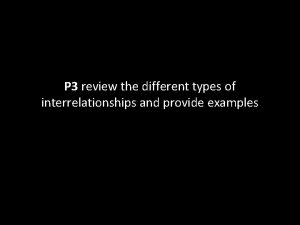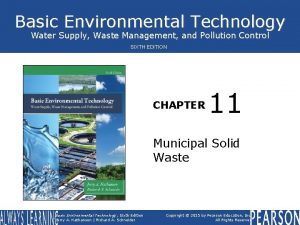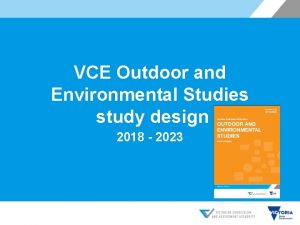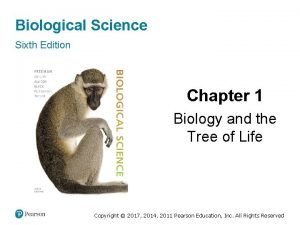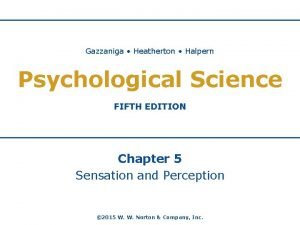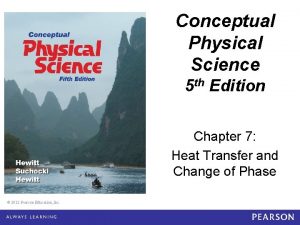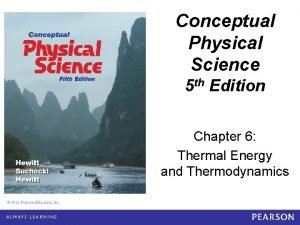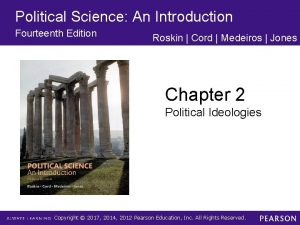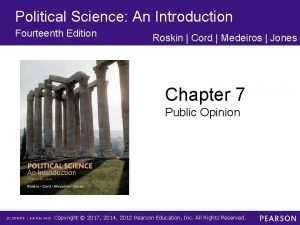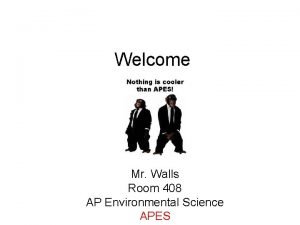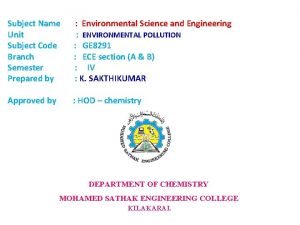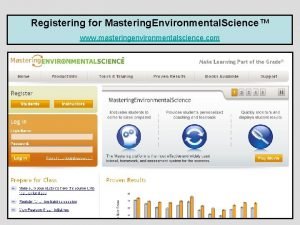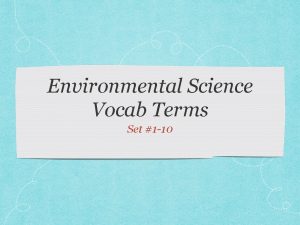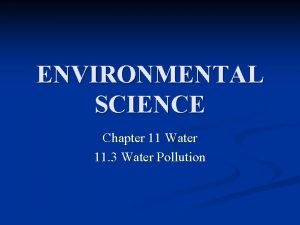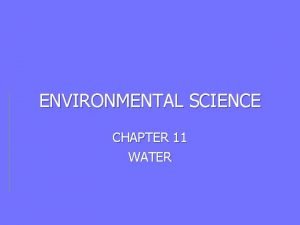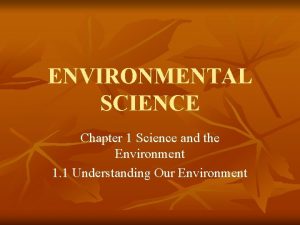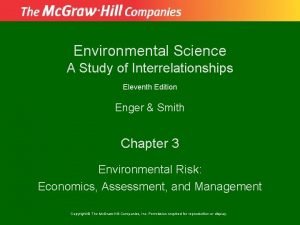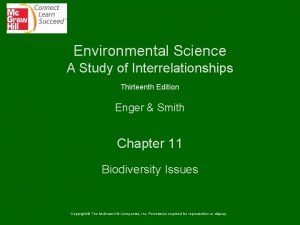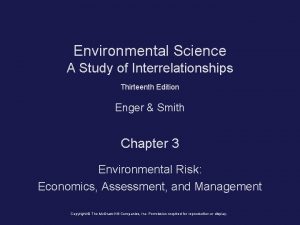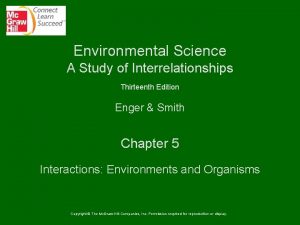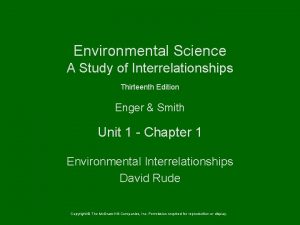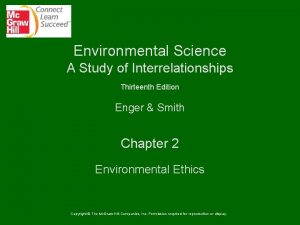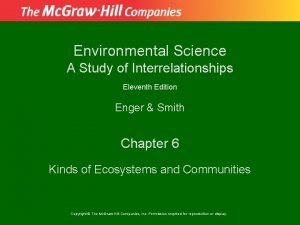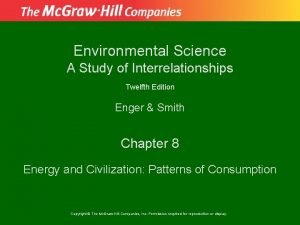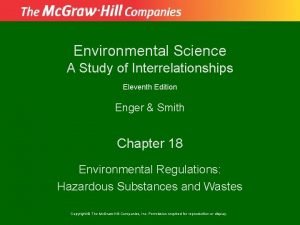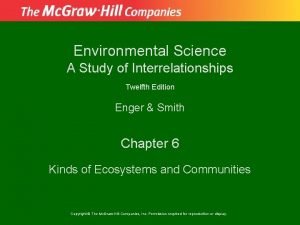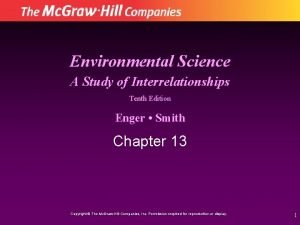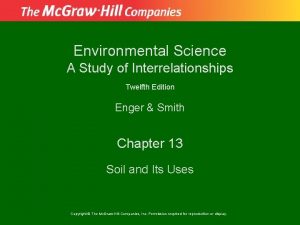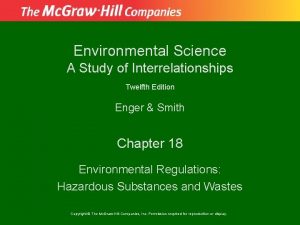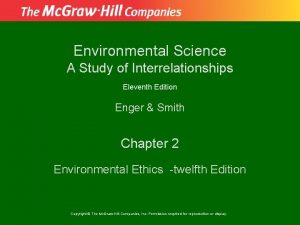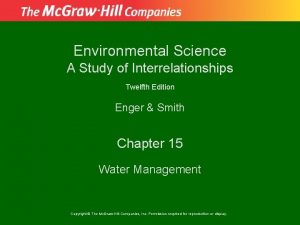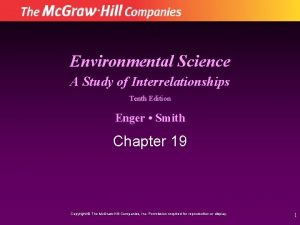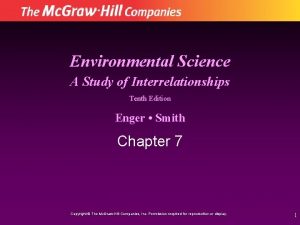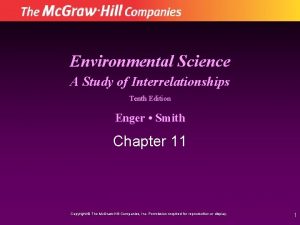Environmental Science A Study of Interrelationships Thirteenth Edition





























- Slides: 29

Environmental Science A Study of Interrelationships Thirteenth Edition Enger & Smith Chapter 1 Environmental Interrelationships Copyright © The Mc. Graw-Hill Companies, Inc. Permission required for reproduction or display.

Environmental Interrelationships

Outline § 1. 1 The Nature of Environmental Science § 1. 2 Emerging Global Issues § 1. 3 Human Well-Being and the Environment

1. 1 The Nature of Environmental Science § Environmental science is interdisciplinary, and includes scientific and social aspects of human impact on the world. • It is a mixture of traditional science, individual and societal values, and political awareness.

1. 1 The Nature of Environmental Science § Environment is everything that affects an organism during its lifetime. Environmental science

Interrelatedness Is a Core Concept § The study of environmental science is so interesting, frustrating, and challenging because of the interrelatedness among seeming unrelated factors. § Tug on anything at all and you’ll find it connected to everything else in the universe. John Muir § Charles Darwin proposed that seed production in red clover was related to the number of cats in the area.

Interrelatedness Is a Core Concept § The reintroduction of wolves to Yellowstone National Park has resulted in many changes. § 31 wolves were introduced in 1995. § In 1996 there were about 320 wolves. § The wolves have caused water flow changes in the park, increases in willow and aspen trees, as well as songbirds, foxes, certain rodents, hawks, and owls. § Coyote and elk have declined.

Interrelatedness Is a Core Concept § The Yellowstone wolves are connected to social, economic, and political realms of human activity. § It was important to environmentalists and biologists to restore the wolf to its former habitat. § Ranchers could lose money if wolves killed livestock. § The farm lobby fought long and hard in congress to prevent the reintroduction. § A fund was developed to pay ranchers for cattle killed by wolves.

An Ecosystem Approach § An ecosystem is a region in which the organisms and the physical environment form an interacting unit. § The task of an environmental scientist is to recognize and understand the natural interactions that take place, and to integrate these with the uses humans must make of the natural world.

1. 2 Emerging Global Issues § Environmental change threatens people’s health, physical security, material needs, and social cohesion.

1. 2 Emerging Global Issues § The World Commission on Environment and Development (Brundtland Commission) concluded 25 years ago that “humanity has the ability to make development sustainable. ”

Environmental Governance § Trade, economic development, good governance, transfer of technology, science and education policies, and globalization have become even more central to sustainable development. § Development strategies need to maintain the ecosystem needs on which long-term development goals depend. • Hurricane Katrina in 2005 demonstrated the link between destruction of coastal wetlands and vulnerability to storms.

Environmental Governance § Most social and political decisions are made with respect to political jurisdictions, but environmental problems do not necessarily coincide with these artificial human made political boundaries. • Air pollution generated in China affects air quality in western coastal states in the United States and in British Columbia, Canada. • Air pollution generated in Juarez, Mexico, causes problems in the neighboring city of EI Paso, Texas

Environmental Governance § Eight U. S. states, two Canadian provinces, and hundreds of local jurisdictions impact environmental decisions in the Great Lakes on pollution, exotic species, fishing, and land use.

1. 3 Human Well-Being and the Environment § The end point of development is human wellbeing. § Human well-being and the quality of the environment are strongly interrelated. • Environmental changes have impacts on human wellbeing.

Defining Human Well-Being § Resources people have, such as money and other assets. The environment is seen only as a means to promote economic growth. § How people feel about their lives, including the cultural importance that environment has for life satisfaction. § What people are able to be and to do. This multidimensional view focuses on what the environment allows individuals to be and to do.

Defining Human Well-Being § Ecosystem services include • Provisioning services: food, water • Regulating services: flood control, disease control • Cultural services: spiritual, recreational, and cultural benefits • Supporting services: nutrient cycling § The world’s poorest people depend primarily on environmental goods and services for their livelihoods.

Environment and Health § The World Health Organization estimates that 13 million deaths worldwide could be prevented every year by environmental improvement. • • Cancer Malaria Coronary Heart Disease Diarrhea

Environment and Health § Urban air pollution affects health in almost every region of the world.

Environment and Security § Security means having stable and reliable access to resources and the ability to be secure from natural and human disasters. § Scarcity of water or other resources can lead to armed conflicts.

Environment and Globalization § Globalization of trade has led to the spread of exotic species. • Zebra Mussel in North America

Environment and Globalization § The first worldwide meeting of heads of state directed toward the environment took place at the Earth Summit (United Nations Conference on Environment and Development) in Rio de Janeiro in 1992. • Most countries at the conference signed agreements on sustainable development and biodiversity.

Environment and Globalization § In 1997, representatives from 125 nations met in Kyoto, Japan for the Third Conference of the United Nations Framework Convention on Climate Change. • The Kyoto Protocol is viewed as one of the most important steps to date in environmental protection and international diplomacy.

Environment and Globalization § The Millennium Ecosystem Assessment was completed in 2005. • As the human population grows, it puts pressure on the natural ecosystems of the world. • Most ecosystems are being negatively affected. • Food production has increased at the expense of soil loss due to erosion, conversion of natural ecosystems to managed systems, and overconsumption of water.

Energy and the Environment § Threat of inadequate and insecure supplies of energy at affordable prices. § Threat of environmental damage due to overconsumption of energy.

Energy and the Environment § Global increases in carbon dioxide emissions are primarily due to fossil fuel use. • Fossil fuels met 82% of the world’s energy demand in 2010.

10 Things You Can Do to Protect Your Environment § § § 1. Reduce driving 2. Save electricity 3. Recycle 4. Conserve water 5. Safely dispose of hazardous waste

10 Things You Can Do to Protect Your Environment § § § 6. Eat locally 7. Donate reusable items 8. Buy in bulk 9. Learn how to avoid the use of insect repellants 10. Be an informed and active citizen

Summary § Environmental science involves science, economics, ethics, and politics in arriving at solutions to environmental problems. § Because ecosystems do not coincide with political boundaries, a regional approach to solving environmental problems is ideal. § Each region of the world has certain environmental issues that are of primary concern because of the mix of population, resource use patterns, and culture.
 Environmental science final exam review
Environmental science final exam review Interdependencies in travel and tourism examples
Interdependencies in travel and tourism examples Why environmental science is an interdisciplinary science
Why environmental science is an interdisciplinary science What is her favourite subject
What is her favourite subject Mis chapter 6
Mis chapter 6 Using mis 10th edition
Using mis 10th edition Basic environmental technology
Basic environmental technology Mh 605
Mh 605 Prehospital emergency care 11th edition
Prehospital emergency care 11th edition Vce outdoor and environmental studies
Vce outdoor and environmental studies Chemistry the central science 14th edition
Chemistry the central science 14th edition Biological science 6th edition
Biological science 6th edition Rotating snake illusion
Rotating snake illusion Conceptual physical science 5th edition
Conceptual physical science 5th edition Conceptual physical science 5th edition
Conceptual physical science 5th edition Conceptual physical science 5th edition
Conceptual physical science 5th edition The fundamentals of political science research 2nd edition
The fundamentals of political science research 2nd edition Political science 14th edition
Political science 14th edition Political science 14th edition
Political science 14th edition Science power 9 atlantic edition
Science power 9 atlantic edition Ap environmental science exam pass rate
Ap environmental science exam pass rate Tragedy of the commons easter island
Tragedy of the commons easter island Environmental science subject code
Environmental science subject code Mastering environmental science
Mastering environmental science About environmental issues
About environmental issues Hudacko
Hudacko Water pollution objectives
Water pollution objectives Water that contains wastes from homes or industry
Water that contains wastes from homes or industry Chapter 1 environmental science
Chapter 1 environmental science Tragedy of commons environmental science
Tragedy of commons environmental science

